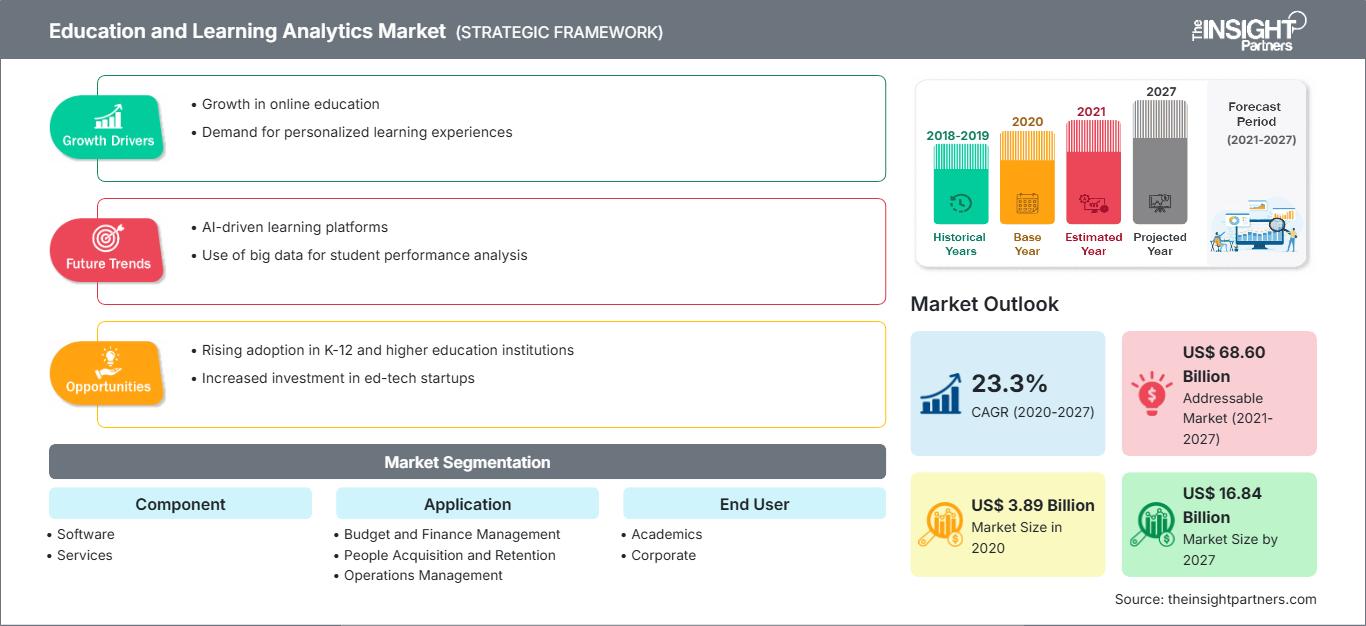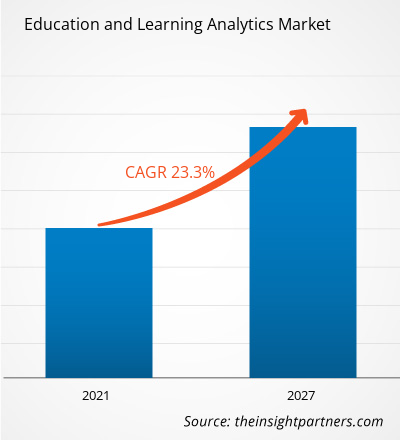[Informe de investigación] Se espera que el mercado de análisis de educación y aprendizaje crezca de 3890,3 millones de dólares estadounidenses en 2020 a 16835,9 millones de dólares estadounidenses en 2027; se estima que crecerá a una tasa de crecimiento anual compuesta (TCAC) del 23,3 % entre 2020 y 2027.
La creciente demanda de cursos en línea y certificaciones profesionales está impulsando el crecimiento del mercado. Esta mayor demanda y el drástico aumento en las inscripciones a programas en línea representan una gran oportunidad para los proveedores que operan en el mercado de la analítica del aprendizaje y la educación. El mercado de cursos en línea está altamente fragmentado debido a la presencia de numerosos actores a nivel mundial. Los proveedores de analítica del aprendizaje deben centrarse en establecer alianzas con proveedores de cursos en línea para expandir su presencia global.
El aprendizaje en línea se está convirtiendo en una parte esencial del panorama educativo. La creciente demanda de programas en línea se debe al aumento de estudiantes que buscan formatos flexibles para obtener certificados, cursos y títulos que les permitan acceder a mejores oportunidades laborales y, a la vez, continuar sus estudios. Los estudiantes matriculados en programas presenciales también se están enfocando en inscribirse en cursos híbridos o completamente en línea. Los másteres en línea están experimentando un auge, ya que muchas instituciones prestigiosas y de gran tamaño están adoptando diversos programas de grado en línea gracias a la asistencia técnica de alta calidad que ofrecen. Además, los profesionales del sector empresarial también se centran en realizar diversos cursos para su desarrollo profesional. Por lo tanto, se espera que la creciente demanda de cursos en línea brinde una gran oportunidad a los proveedores de análisis de aprendizaje y educación a nivel mundial.
Obtendrá personalización gratuita de cualquier informe, incluyendo partes de este informe, análisis a nivel de país y paquetes de datos de Excel. Además, podrá aprovechar excelentes ofertas y descuentos para empresas emergentes y universidades.
Mercado de análisis de educación y aprendizaje: Perspectivas estratégicas

-
Obtenga las principales tendencias clave del mercado que se describen en este informe.Esta muestra GRATUITA incluirá análisis de datos, que abarcarán desde tendencias de mercado hasta estimaciones y pronósticos.
Impacto de la pandemia de COVID-19 en el mercado de análisis de la educación y el aprendizaje
Aunque existen diversas opiniones sobre los daños que puede causar la COVID-19, lo cierto es que se está propagando por todo el mundo. Los nuevos casos están aumentando en lugares como Estados Unidos, Canadá, Europa, África, Oriente Medio, India, Australia, Corea del Sur y Japón, entre otros países. Si bien se conocen bien las repercusiones en diversos sectores, el sector educativo también se enfrenta a la mayor disrupción de los últimos tiempos.
Las instituciones educativas de todo el mundo están respondiendo a las prohibiciones de viaje y las cuarentenas con una transición a la enseñanza en línea. La emergencia podría impulsar un auge de la educación en línea, o al menos preparar mejor a los países para afrontar la próxima emergencia.
Perspectivas de mercado: Mercado de análisis de educación y aprendizaje
Mayor adopción de tecnología avanzada entre las instituciones educativas de los países en desarrollo
Las instituciones educativas están invirtiendo fuertemente en tecnología avanzada para obtener una ventaja competitiva y adoptar el mejor sistema educativo posible. Por otro lado, los estudiantes también están dispuestos a invertir para obtener la mejor educación. Tanto las instituciones educativas como los estudiantes tienen un alto potencial de inversión en el sistema educativo impulsado por la tecnología, que está teniendo un gran impacto en el crecimiento del mercado. Las escuelas y universidades están invirtiendo en tecnología para mejorar sus operaciones educativas, como la planificación financiera, la planificación de cursos, la retención estudiantil y la eficacia en la transmisión de información a los estudiantes.
El sector educativo ha experimentado con avances tecnológicos tan diversos como los programas presenciales y el aprendizaje mediante aplicaciones. Algunas de estas tecnologías se han integrado de forma permanente al sistema de educación superior. La rápida evolución tecnológica está transformando el sector educativo.
Las tecnologías avanzadas, como el análisis de macrodatos, ofrecen a los educadores oportunidades sin precedentes para conectar con sus estudiantes de una forma innovadora. Proporcionan una comprensión más profunda de la experiencia de aprendizaje de los estudiantes y ayudan a evaluar el estado del sistema educativo. Algunas de las áreas clave donde los macrodatos desempeñan un papel fundamental en el sector educativo son los programas personalizados, la mejora del rendimiento estudiantil, la reducción del abandono escolar, entre otras. Asimismo, la analítica del aprendizaje permite optimizar la impartición de los cursos, la gestión del rendimiento, la gestión operativa, la gestión financiera, etc. Todas estas ventajas asociadas a las tecnologías permiten a las instituciones educativas adoptar soluciones tecnológicas inteligentes. Se prevé que la creciente adopción de soluciones tecnológicas avanzadas en el sector educativo impulse el mercado global de la educación y la analítica del aprendizaje durante el período de pronóstico.
Información basada en componentes
Según su componente, el mercado de análisis de datos para la educación y el aprendizaje se segmenta en software y servicios. El segmento de software ostentó la mayor cuota de mercado en 2019.
Los actores que operan en el mercado de la analítica educativa y del aprendizaje se centran principalmente en el desarrollo de productos avanzados y eficientes.
- En 2019, SAS Institute Inc. invirtió en el talento detrás del análisis de datos, con el fin de formar a la nueva generación para que transforme lo posible y capacitar a la fuerza laboral para una economía en constante cambio. Durante el SAS® Global Forum 2019 se presentaron varios programas e iniciativas nuevas, que forman parte del compromiso general de SAS con la promoción de la formación en análisis de datos para todos.
- En 2019, Microsoft adquirió DataSense, una plataforma de integración como servicio (IPaaS) dirigida a proveedores de soluciones educativas y distritos escolares estadounidenses, a la empresa BrightBytes de San Francisco. El equipo de desarrollo se integrará a la división global de educación de Microsoft como parte del acuerdo.
El mercado de análisis de datos para la educación y el aprendizaje se ha segmentado de la siguiente manera:
Perspectivas regionales del mercado de análisis de la educación y el aprendizaje
Los analistas de The Insight Partners han explicado en detalle las tendencias y los factores regionales que influyen en el mercado de la analítica educativa y del aprendizaje durante el período de previsión. Esta sección también analiza los segmentos y la geografía del mercado de la analítica educativa y del aprendizaje en Norteamérica, Europa, Asia Pacífico, Oriente Medio y África, y Sudamérica y Centroamérica.
Alcance del informe de mercado de análisis de educación y aprendizaje
| Atributo del informe | Detalles |
|---|---|
| Tamaño del mercado en 2020 | 3.890 millones de dólares estadounidenses |
| Tamaño del mercado para 2027 | 16.840 millones de dólares estadounidenses |
| Tasa de crecimiento anual compuesto global (2020 - 2027) | 23,3% |
| Datos históricos | 2018-2019 |
| período de previsión | 2021-2027 |
| Segmentos cubiertos |
Por componente
|
| Regiones y países cubiertos |
América del norte
|
| Líderes del mercado y perfiles de empresas clave |
|
Densidad de los actores del mercado de análisis de la educación y el aprendizaje: comprensión de su impacto en la dinámica empresarial
El mercado de analítica educativa y del aprendizaje está creciendo rápidamente, impulsado por la creciente demanda de los usuarios finales debido a factores como la evolución de las preferencias de los consumidores, los avances tecnológicos y una mayor conciencia de los beneficios del producto. A medida que aumenta la demanda, las empresas amplían su oferta, innovan para satisfacer las necesidades de los consumidores y aprovechan las tendencias emergentes, lo que impulsa aún más el crecimiento del mercado.

- Obtenga una visión general de los principales actores del mercado de análisis de educación y aprendizaje.
Mercado de análisis de datos en educación y aprendizaje – por componente
- Software
- Servicios
Mercado de análisis de datos en educación y aprendizaje: por aplicación
- Gestión del desempeño
- Gestión de Operaciones
- Gestión presupuestaria y financiera
- Adquisición y retención de personal
- Desarrollo curricular y gestión de intervenciones
Mercado de análisis de datos en educación y aprendizaje: por usuario final
- Académica
- Corporativo
Mercado de análisis de datos en educación y aprendizaje – por geografía
-
América del norte
- A NOSOTROS
- Canadá
- México
-
Europa
- Francia
- Alemania
- Italia
- Rusia
- Reino Unido
- El resto de Europa
-
Asia Pacífico (APAC)
- Japón
- Porcelana
- Australia
- India
- Corea del Sur
- Resto de Asia Pacífico
-
Oriente Medio y África (MEA)
- Arabia Saudita
- Emiratos Árabes Unidos
- Sudáfrica
- Resto de Oriente Medio y África
-
Sudamérica (SAM)
- Brasil
- Argentina
- El resto de SAM
Mercado de análisis de datos en educación y aprendizaje: perfiles de empresas
- Sistemas de cuencas hidrográficas, Inc.
- SAS Institute Inc.
- SAP SE
- Corporación Microsoft
- Mentes más felices
- Ellucian Company LP
- Blackboard Inc.
- Alteryx Inc.
- InetSoft Technology Corp.
- Saba Software, Inc.
- Análisis histórico (2 años), año base, pronóstico (7 años) con CAGR
- Análisis PEST y FODA
- Tamaño del mercado, valor/volumen: global, regional y nacional
- Industria y panorama competitivo
- Conjunto de datos de Excel
Informes recientes
Testimonios
Razón para comprar
- Toma de decisiones informada
- Comprensión de la dinámica del mercado
- Análisis competitivo
- Información sobre clientes
- Pronósticos del mercado
- Mitigación de riesgos
- Planificación estratégica
- Justificación de la inversión
- Identificación de mercados emergentes
- Mejora de las estrategias de marketing
- Impulso de la eficiencia operativa
- Alineación con las tendencias regulatorias






















 Obtenga una muestra gratuita para - Mercado de análisis de educación y aprendizaje
Obtenga una muestra gratuita para - Mercado de análisis de educación y aprendizaje